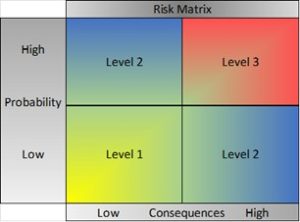The Door Security and Safety Foundation (DSSF), in partnership with the Door and Hardware Institute (DHI), has established a task force comprising experts to recommend security levels necessary for building openings, given the absence of national standards. The three specified levels are designed for public use, aiming to educate and offer guidance on specifying and equipping secure openings in any project. The primary objectives of these levels are to Deter, Detect, and Delay adversarial behavior, providing valuable time for emergency response personnel.
In the evaluation of security levels, it is crucial to factor in the probability of risk. When assessing the risk associated with adversarial behavior at exterior or interior perimeter openings, quantifying the risk becomes essential by considering both the likelihood of the event occurring and its potential consequences. This assessment serves as a guide for users in determining the most suitable mitigation recommendations outlined below.
3 Levels of Secure Openings:
The outlined security levels are of a general nature, applicable to diverse structures and building types, serving as a foundational design reference.

Level 1 – Basic level of control and security (See appendix A):
Openings are flush, with or without a visible glass area within the door. They are securely latched, locked, and feature controlled or monitored access, either mechanical or electronic. When monitoring is employed, it should encompass both the door position within the opening and the latch position.
Level 2 – Intermediate level of control and security (See appendix A):
Openings are flush or may include a visible glass area within the door. They are securely latched, locked, and incorporate electronic access control with monitored access. Monitoring, at a minimum, covers the door position within the opening and latch position.
Level 3 – High level of control and security (See appendix A):
Openings are flush or may contain a visible glass area within the door. They are securely latched, locked, and designed to swing out. The doors are constructed with UL-rated materials for bullet resistance, including appropriate core material and glazing if applicable. Additionally, they feature electronic access control and monitored access. Monitoring, at a minimum, must encompass both the door position and latch position.
#HelpBuildingsServePeople




